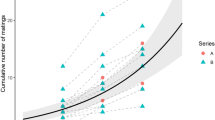Abstract
This paper determines the influence of initial age at mating on the primary sex-ratio of the two-spotted spider miteTetranychus urticae Koch. The specific question asked is whether females that mate at ages beyond ecdysis, or are inseminated at ecdysis by virgin males of set ages, have daughter productions different from control females mated at ecdysis by randomly aged males.
Age of initial female mating did not effect survival. Females mated at ecdysis produced more daughters than those mated at age 5 or 10 days. However, daughter production was equal for all female treatments in the post-mating period. All treatments stopped producing daughters at approximately the same age, regardless of when mated. Son production was lowest for females mated at ecdysis. However, son production by females mated when 5 or 10 days old was lower than that of females mated at ecdysis.
Male age at mating did not effect female survival. Females exposed to virgin males either 1 or 7 days old produced more daughters than those exposed to males either 11 or 20 days of age. However, a substantial proportion of females in these latter cohorts were not mated. If only mated females are considered, daughter production is the same between all cohorts.
Delayed age at first mating influenced sex-ratio only via the females, specifically by changes in daughter production (as opposed to changes in survivorship). Daughters that would have been produced between ecdysis and mating were never recovered by females that mated at ages beyond ecdysis. Thus, these daughters were ‘lost’ from a sex-ratio viewpoint. Initial age of male mating did not change sex-ratio.
Similar content being viewed by others
References
Boudreaux, H.B., 1963. Biological aspects of some phtyophagous mites. Annu. Rev. Entomol., 8: 137–154.
Carey, J.R. and Krainacker, D.A., 1988. Demographic analysis of mite populations: extensions of stable theory. Exp. Appl. Acarol., 4: 191–210.
Davis, D.W., 1961. Biology ofTetranychus ‘multisetis’, the polychaetus form ofTetranychus cinnabarinus (Acarina: Tetranychidae). Ann. Entomol. Soc. Am., 54: 30–54.
DeMoraes, G.J. and McMurtry, J.A., 1987. Effect of the temperature and sperm supply on the reproductive potential ofTetranychus evansi (Acari: Tetranychidae). Exp. Appl. Acarol., 3: 95–107.
Hamilton, W.D., 1967. Extraordinary sex ratios. Science, 156: 477–488.
Hamilton, A., Botsford, L.W. and Carey, J.R., 1986. Demographic examination of sex ratio in the twospotted spider mite,Tetranychus urticae. Entomol. Exp. Appl., 41: 147–151.
Helle, W., 1967. Fertilization in the twospotted spider mite (Tetranychus urticae: Acari). Entomol. Exp. Appl., 10: 103–110.
Krainacker, D.A. and Carey, J.R., 1988. Maternal heterogeneity in primary sex-ratio of three tetranychid mites. Exp. Appl. Acarol., 5: 151–162.
Krainacker, D.A. and Carey, J.R., 1989. Reproductive limits and heterogeneity of male two-spotted spider mites. Entomol. Exp. Appl., 50: 209–214.
Krainacker, D.A. and Carey, J.R., 1990. Male demographic constraints to extreme sex ratio in the twospotted spider mite. Oecologia, 82: 417–123.
Laing, J.E., 1969. Life history and life table ofTetranychus urticae Koch. Acaroliga, 11: 32–42.
Mitchell, R., 1970. An analysis of dispersal in mites. Am. Nat., 104: 425–431.
Mitchell, R., 1973. Growth and population dynamics of a spider miteTetranychus urticae K., (Acarina: Tetranychidae). Ecology, 54: 1349–1355.
Overmeer, W.P.J. and Harrison, R.A., 1969. Notes on the control of the sex ratio in populations in the twospotted spider mite,Tetranychus urticae Koch (Acarina: Tetranychidae), N. Z. J. Sci., 12: 920–928.
Pijnacker, L.P. and Drenth-Diephuis, L.J., 1973. Cytological investigations on the male reproductive system and the sperm track in the spider miteTetranychus urticae Koch (Tetranychidae, Acarina). Neth. J. Zool., 23: 446–464.
Potter, D.A., 1978a. Functional sex ratio in the carmine spider mite. Ann. Entomol. Soc. Am., 71: 218–222.
Potter, D.A., 1978b. Interrupted matings and the effectiveness of second inseminations in the twospotted spider mite. Ann. Entomol. Soc. Am., 71:882–885.
Shih, C., 1979. The influence of age of femaleTetranychus kanzawai on sex ratio and life cycle of its progeny. In: J.G. Rodriguez (Editor) Recent Advances in Acarology, Vol. 2. Academic, New York, pp. 511–517.
Werren, J.H. and Charnov, E.L., 1978. Facultative sex ratios and population dynamics. Nature, 272: 349–350.
Wrensch, D.L., 1979. Components of reproductive success in spider mites. In: J.G. Rodriguez (Editor), Recent Advances in Acarology, Vol. 2 Academic, New York, pp. 155–164.
Wrensch, D.L. and Flechtmann, C.H.W., 1978. Extraordinary sex ratio in a carmine spider mite. Cienc. Cult. (Maracaibo), 31: 1039–1040.
Wrensch, D.L. and Young, S.S.Y., 1978. Effects of density and host quality on rate of development, survivorship, and sex ratio in the carmine spider mite. Environ. Entomol., 7: 499–501.
Wrensch, D.L. and Young, S.S.Y., 1983. Relationship between primary and tertiary sex ratio in the twospotted spider mite (Acarina: Tetranychidae). Ann. Entomol. Soc. Am., 76: 786–789.
Author information
Authors and Affiliations
Rights and permissions
About this article
Cite this article
Krainacker, D.A., Carey, J.R. Effect of age at first mating on primary sex-ratio of the two-spotted spider mite. Exp Appl Acarol 9, 169–175 (1990). https://doi.org/10.1007/BF01193426
Accepted:
Issue Date:
DOI: https://doi.org/10.1007/BF01193426




